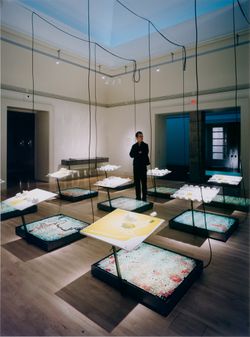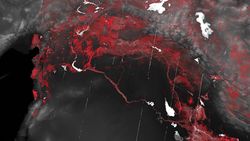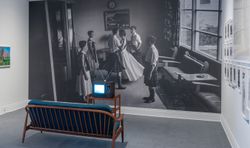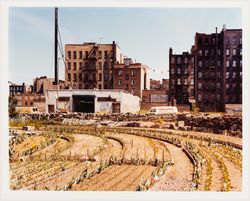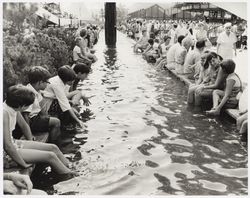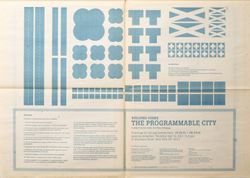archives
Level of archival description:
Fonds
Zdzislaw Przygoda fonds
AP126
Synopsis:
Le Fonds Zdzislaw Przygoda (Sir Casimir Gzowski Memorial) est composé de deux dessins, d'une photographie et de documents textuels, principalement de la correspondance, relatifs au projet de construire un monument commémoratif à Toronto à la mémoire de l'ingénieur polonais Sir Casimir Gzowski (1813-1898). Les documents produits et colligés par Zdzislaw Przygoda, vice-président exécutif du Sir Casimir Gzowski Memorial Centennial Committee, nous renseignent sur l'évolution du projet.
1963-1967
Zdzislaw Przygoda fonds
Actions:
AP126
Synopsis:
Le Fonds Zdzislaw Przygoda (Sir Casimir Gzowski Memorial) est composé de deux dessins, d'une photographie et de documents textuels, principalement de la correspondance, relatifs au projet de construire un monument commémoratif à Toronto à la mémoire de l'ingénieur polonais Sir Casimir Gzowski (1813-1898). Les documents produits et colligés par Zdzislaw Przygoda, vice-président exécutif du Sir Casimir Gzowski Memorial Centennial Committee, nous renseignent sur l'évolution du projet.
archives
Level of archival description:
Fonds
1963-1967
The American Lawn: Surface of Everyday Life reveals the lawn as a domestic symbol, civic showplace, economic force, and national icon. Bungalows in tract developments, suburban corporate headquarters, and the White House are all alike in that they sit behind a lawn: a carefully contrived patch of “nature” that lies open to the sky and to a multitude of uses and(...)
Main galleries, octagonal gallery, and hall cases
16 June 1998 to 8 November 1998
The American Lawn: Surface of Everyday Life
Actions:
Description:
The American Lawn: Surface of Everyday Life reveals the lawn as a domestic symbol, civic showplace, economic force, and national icon. Bungalows in tract developments, suburban corporate headquarters, and the White House are all alike in that they sit behind a lawn: a carefully contrived patch of “nature” that lies open to the sky and to a multitude of uses and(...)
Main galleries, octagonal gallery, and hall cases
archives
Level of archival description:
Fonds
Álvaro Siza fonds
AP178
Description:
The Álvaro Siza fonds documents the architectural work of Portuguese architect Álvaro Siza. Records in this fonds document Siza’s projects from 1958-2012, including built and unbuilt designs. A collaborative project was established between the Canadian Centre for Architecture (CCA), Fundação de Serralves, and Fundação Calouste Gulbenkian to allow for international research and access to the archive. The archive is shared by the three institutions with each institution holding different projects while collaborating on the descriptive work and increasing the visibility of the archive. The holdings at both the Fundação de Serralves and Fundação Calouste Gulbenkian focus on Siza’s Portuguese projects, while the portion of the archive held by the CCA mainly includes Siza’s projects abroad. All three institutions are committed to describing the archive and making it accessible for scholarly research. The processing of the Siza archive held by the CCA has been divided into four phases to allow for access to parts of the archive while still in process. For the first, second, and third phases, the processing archivist has described the projects from the fifties, sixties, and seventies, as well as projects for the IBA competition in Berlin, urban renewal projects in The Hague from the eighties, urban plans, museums, and individual houses between 1980 and 2000. The processing archivist has also described approximately 203 sketchbooks. Many of these sketchbooks include sketches related to architectural projects which were processed. The complete list of projects processed by the CCA to date can be found in series AP178.S1. The bulk of the Álvaro Siza fonds is arranged in Series AP178.S1, which contains documentation for over 200 of Siza’s architectural projects. Records in this archive are predominantly from 1970 to 2000. Series AP178.S1 mainly contains conceptual, design development, presentation, and working drawings. Also included are photographic materials, models, born digital records, and textual documentation, which include correspondence, project proposals, and notes. The architect’s creative process is captured in 282 sketchbooks arranged in Series AP178.S2. In all there are approximately 60 000 drawings, 3000 folders of textual documentation, 9.46 linear meters of photographs and negatives, 6,545 slides, 250 CD-ROMS, 101 floppy disks, and 371 models that document the architectural activities of Siza and his office. Among the drawings are sketches by Siza on various items, such as napkins, receipts, envelopes, or on the back of working drawings. The fonds contains several types of architectural projects including residential buildings, museums, universities, urban plans, offices, and city restorations. Of particular significance are the sketchbooks, comprised of sketches for architectural projects, Siza’s travels, people, and animals as well as notes and draft letters. The sketchbooks are organized in chronological order, starting in the late 1970’s to the beginning of the 2000’s. Locations, notes, and dates have also been identified on the front of each sketchbook along with the sketchbook number. The sketchbooks provide a unique perspective of Siza’s use of drawing as part of his work process.
1958-2002
Álvaro Siza fonds
Actions:
AP178
Description:
The Álvaro Siza fonds documents the architectural work of Portuguese architect Álvaro Siza. Records in this fonds document Siza’s projects from 1958-2012, including built and unbuilt designs. A collaborative project was established between the Canadian Centre for Architecture (CCA), Fundação de Serralves, and Fundação Calouste Gulbenkian to allow for international research and access to the archive. The archive is shared by the three institutions with each institution holding different projects while collaborating on the descriptive work and increasing the visibility of the archive. The holdings at both the Fundação de Serralves and Fundação Calouste Gulbenkian focus on Siza’s Portuguese projects, while the portion of the archive held by the CCA mainly includes Siza’s projects abroad. All three institutions are committed to describing the archive and making it accessible for scholarly research. The processing of the Siza archive held by the CCA has been divided into four phases to allow for access to parts of the archive while still in process. For the first, second, and third phases, the processing archivist has described the projects from the fifties, sixties, and seventies, as well as projects for the IBA competition in Berlin, urban renewal projects in The Hague from the eighties, urban plans, museums, and individual houses between 1980 and 2000. The processing archivist has also described approximately 203 sketchbooks. Many of these sketchbooks include sketches related to architectural projects which were processed. The complete list of projects processed by the CCA to date can be found in series AP178.S1. The bulk of the Álvaro Siza fonds is arranged in Series AP178.S1, which contains documentation for over 200 of Siza’s architectural projects. Records in this archive are predominantly from 1970 to 2000. Series AP178.S1 mainly contains conceptual, design development, presentation, and working drawings. Also included are photographic materials, models, born digital records, and textual documentation, which include correspondence, project proposals, and notes. The architect’s creative process is captured in 282 sketchbooks arranged in Series AP178.S2. In all there are approximately 60 000 drawings, 3000 folders of textual documentation, 9.46 linear meters of photographs and negatives, 6,545 slides, 250 CD-ROMS, 101 floppy disks, and 371 models that document the architectural activities of Siza and his office. Among the drawings are sketches by Siza on various items, such as napkins, receipts, envelopes, or on the back of working drawings. The fonds contains several types of architectural projects including residential buildings, museums, universities, urban plans, offices, and city restorations. Of particular significance are the sketchbooks, comprised of sketches for architectural projects, Siza’s travels, people, and animals as well as notes and draft letters. The sketchbooks are organized in chronological order, starting in the late 1970’s to the beginning of the 2000’s. Locations, notes, and dates have also been identified on the front of each sketchbook along with the sketchbook number. The sketchbooks provide a unique perspective of Siza’s use of drawing as part of his work process.
archives
Level of archival description:
Fonds
1958-2002
Territories are the complex set of relations to things that keep us alive. They are bound spaces, where intersecting borders establish semi-stable relations between polities and their material base of operations. A new intensification is reshaping the surface and the cycles of the Earth: the Anthropocene marks an exit from modern forms of territorial organization of(...)
Paul-Desmarais Theatre
5 November 2015
John Palmesino: Territorial Agency
Actions:
Description:
Territories are the complex set of relations to things that keep us alive. They are bound spaces, where intersecting borders establish semi-stable relations between polities and their material base of operations. A new intensification is reshaping the surface and the cycles of the Earth: the Anthropocene marks an exit from modern forms of territorial organization of(...)
Paul-Desmarais Theatre
In an age of unprecedented human impact on the planet, certain countries stand out for their privileged positions and the complexity of their relationships with the land. Stories about Canada closely follow the discovery and appropriation of vast and varied natural resources as well as changing ideas of the proper relationship between people and their environment.(...)
16 November 2016 to 9 April 2017
It’s All Happening So Fast
Actions:
Description:
In an age of unprecedented human impact on the planet, certain countries stand out for their privileged positions and the complexity of their relationships with the land. Stories about Canada closely follow the discovery and appropriation of vast and varied natural resources as well as changing ideas of the proper relationship between people and their environment.(...)
Pollinaction
On the occasion of Earth Day, become agents of urban pollination to counter the decline of pollinating insects and nectar-producing plants. In collaboration with Éco-quartier Peter-McGill, discover how monarchs, bees, and milkweed contribute to the richness of the city’s biodiversity. Then get your hands dirty by creating seed bombs to disseminate during an exploration of(...)
24 April 2016
Pollinaction
Actions:
Description:
On the occasion of Earth Day, become agents of urban pollination to counter the decline of pollinating insects and nectar-producing plants. In collaboration with Éco-quartier Peter-McGill, discover how monarchs, bees, and milkweed contribute to the richness of the city’s biodiversity. Then get your hands dirty by creating seed bombs to disseminate during an exploration of(...)
archives
Level of archival description:
Fonds
Joseph Rykwert fonds
AP209
Synopsis:
The Joseph Rykwert fonds, 1928-2022, documents Joseph Rykwert’s career as an architectural historian, author and professor. The fonds includes the records for over a dozen monographs written between the mid-1960s and the mid-2010s as well as edited works and articles, and details his teaching and lecturing activities from the 1960s onwards in universities in Europe and the United States. The records highlight Joseph Rykwert’s multidisciplinary approach, which involved archaeology, anthropology and psychoanalysis in his study of the history and theory of architecture and of the urban form. The fonds is composed of textual records, publications and ephemera, and of photographs including multiple albums and a large number of slides; the fonds also documents Joseph Rykwert’s career as an independent designer through drawings realized between the late 1940s and the late 1970s.
1928-2022
Joseph Rykwert fonds
Actions:
AP209
Synopsis:
The Joseph Rykwert fonds, 1928-2022, documents Joseph Rykwert’s career as an architectural historian, author and professor. The fonds includes the records for over a dozen monographs written between the mid-1960s and the mid-2010s as well as edited works and articles, and details his teaching and lecturing activities from the 1960s onwards in universities in Europe and the United States. The records highlight Joseph Rykwert’s multidisciplinary approach, which involved archaeology, anthropology and psychoanalysis in his study of the history and theory of architecture and of the urban form. The fonds is composed of textual records, publications and ephemera, and of photographs including multiple albums and a large number of slides; the fonds also documents Joseph Rykwert’s career as an independent designer through drawings realized between the late 1940s and the late 1970s.
archives
Level of archival description:
Fonds
1928-2022
Sink or Swim
What would a city look like if its infrastructure was waterproof, buoyant and–why not!–amphibious? Given the anticipated rise of sea level at a global scale, the connection between the city and water in all its iterations–oceans, rivers, canals, waterways–is subject to change in the coming years. Montreal will be the playground of this creative laboratory of prototypes(...)
February 2017 to March 2017
Sink or Swim
Actions:
Description:
What would a city look like if its infrastructure was waterproof, buoyant and–why not!–amphibious? Given the anticipated rise of sea level at a global scale, the connection between the city and water in all its iterations–oceans, rivers, canals, waterways–is subject to change in the coming years. Montreal will be the playground of this creative laboratory of prototypes(...)
The City Decoded
What if we played to re-imagine Montreal? After decoding the spatial policies linked to the planning of your city, it is your turn to rethink the urban fabric by combining houses, stores, parks, factories and corner stores. Montreal is transformed into a board game and its buildings and roads turned into game pieces. Noise management, sunlight, pollution and mixed-use(...)
The Other Architect
7 February 2016 to 21 February 2016
The City Decoded
Actions:
Description:
What if we played to re-imagine Montreal? After decoding the spatial policies linked to the planning of your city, it is your turn to rethink the urban fabric by combining houses, stores, parks, factories and corner stores. Montreal is transformed into a board game and its buildings and roads turned into game pieces. Noise management, sunlight, pollution and mixed-use(...)
The Other Architect
photographs
Quantity:
9 photograph(s)
Photographs of Le Corbusier
ARCH268907
Description:
Group consists of photographs of Le Corbusier, of his friends, including Amédée Ozenfant, his relations and of his travels. There is a photograph of the Athens Acropolis in Greece. The group also includes a photograph of Le Corbusier aged about 15 years old.
Photographs of Le Corbusier
Actions:
ARCH268907
Description:
Group consists of photographs of Le Corbusier, of his friends, including Amédée Ozenfant, his relations and of his travels. There is a photograph of the Athens Acropolis in Greece. The group also includes a photograph of Le Corbusier aged about 15 years old.
photographs
Quantity:
9 photograph(s)
